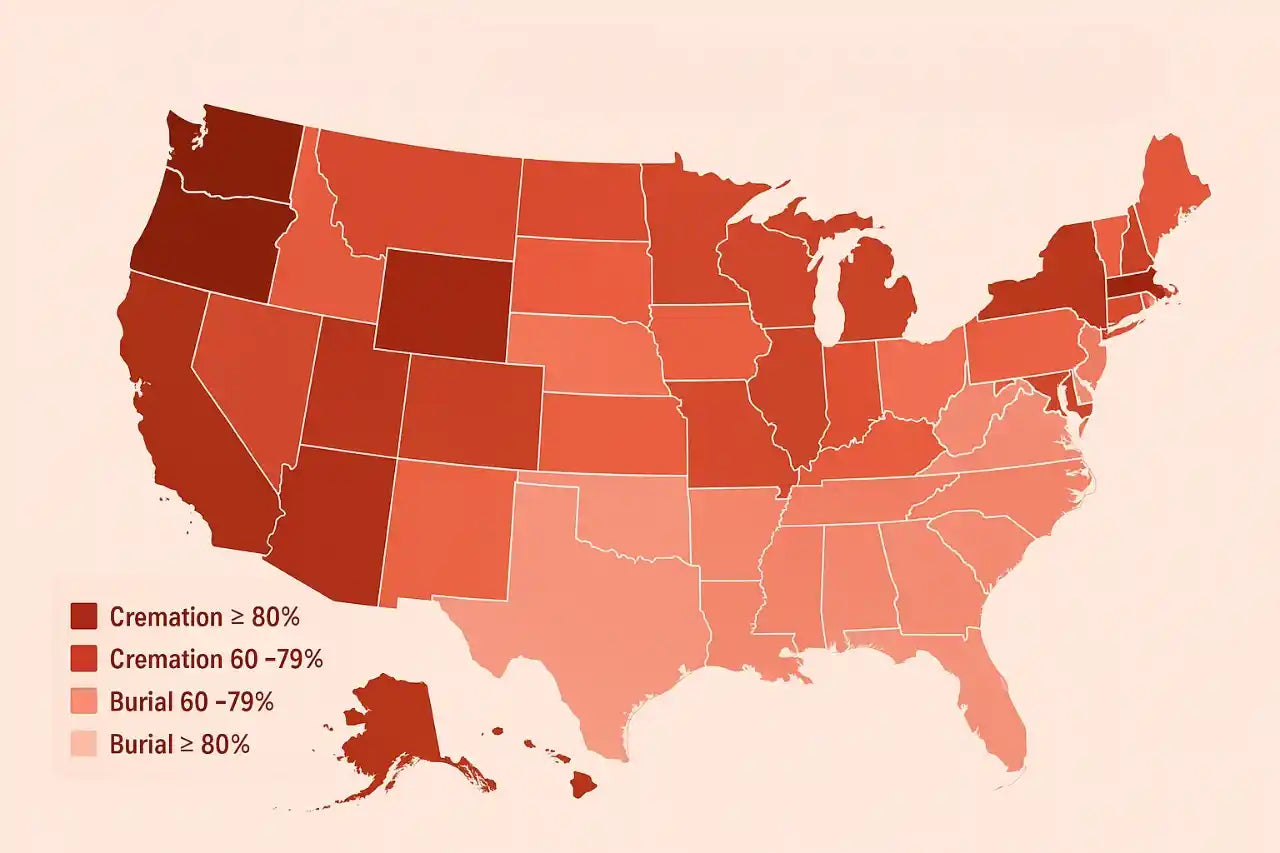Losing someone close to you is heavy. The last thing most people want to think about in the middle of all that grief is logistics. But after the funeral, there’s still a gravesite that needs to be marked. And permanent headstones? They take time. Sometimes months. So families are left with a simple but necessary choice; use a temporary grave marker.
It might not seem like a big deal at first, but that small marker carries weight. It’s often the only thing standing there while everything else is in motion. Some are provided by the funeral home, others are bought online, and a few are made by hand. Some last, some don’t. Some look respectful, others barely hold up after a few rainstorms. Still, it serves a purpose; it gives loved ones a place to return to, even if the final stone isn’t ready yet.
In this guide, we’ll talk about the pros and cons, what to expect in terms of price, and whether it’s worth getting something custom while you wait for the permanent marker.

What Are Temporary Grave Markers?
Temporary grave markers are often the quiet, unspoken part of burial planning, but they play a real and necessary role in the grieving process. These are simple markers that stand in place of a permanent headstone. They’re typically made from less durable materials like plastic, wood, aluminum, or lightweight metal, and are placed on the grave shortly after a burial or cremation ceremony. They’re not built to last forever.
But in those first few weeks or months, they hold space. For families trying to catch their breath after a loss, temporary grave markers provide something physical, something real, where people can come and pay their respects.
What separates a temporary grave marker from a permanent headstone is intention and timing. Permanent headstones are made to last carved in granite or bronze, crafted with care to last for decades, even centuries. They're deliberate, final, and often come with emotional weight and significant cost. Temporary markers, on the other hand, give families time. Time to decide what they want the final memorial to look like. Time to figure out the budget. They’re often provided by funeral homes or cemeteries, sometimes at no extra cost, and they typically include basic details like the name of the deceased, date of birth and death, and maybe a short phrase or religious symbol.

You’ll often see temporary grave markers used when families are still in the process of designing a headstone. Some families want to involve multiple people in the decision, especially when the person who passed held deep significance to many. Other times, it’s about money. Let’s be honest, memorials aren’t cheap. Not every family can drop thousands of dollars immediately after paying for a funeral.
Types of Temporary Grave Markers
Funeral Home Markers
This is the type most people will encounter first. After the burial, the funeral home typically places a small marker at the head of the grave. It’s a standard gesture, and it’s usually done without charging extra. The marker itself is functional, not decorative, it’s there to identify the grave until something permanent is installed. Most of these are made from durable plastic or lightweight aluminum, designed to handle the weather for a few weeks or months, but nothing more.
They often feature a clear window or sleeve holding a laminated card with the name, birth, and death dates, and sometimes the funeral home’s branding. It’s utilitarian, clean, and easily replaceable. Funeral home markers are not designed to express personality. They serve one core purpose: to make sure the grave is properly identified while decisions are still being made. And for many families, that’s all they need at this stage.
DIY or Custom Temporary Markers
For families who want something with more heart, more of them in it, DIY or custom temporary markers offer a chance to be hands-on. Wooden crosses are probably the most common choice in this category, but even those vary. Some are hand-carved. Some are store-bought and painted at home. Others include embellishments or engraved plates.
Garden stakes with small signs, hand-painted rocks, or even custom-engraved plaques can also be used. What makes these different is the level of intention. People often add nameplates, dates, short messages, or even quotes that meant something to the person who passed. And while these aren’t built to last years, the care that goes into them makes them powerful in the short term.
There’s something uniquely moving about a handmade marker. It reflects the reality of grief that you’re still figuring things out, still coping, but that you haven’t forgotten. You’re making space for remembrance in your own way. Sometimes, that’s more comforting than anything a machine-cut slab of granite could say.
Commercially Available Temporary Markers
Then there’s a third option; temporary grave markers you can buy, either from a monument company or online retailers that specialize in memorial items. These aren’t the standard funeral home-issued tags, nor are they DIY projects. They’re something in between, offering more structure and durability than a laminated card, but without the cost or time involved in a permanent headstone.

You’ll find markers made of metal, often coated to withstand the elements, as well as wooden options with protective finishes. Some families opt for biodegradable versions, especially if they plan to move or replace the marker soon and want something that will naturally return to the earth. These markers can be surprisingly elegant. Some even allow for small engravings or custom inscriptions.
The appeal here is in the balance. You don’t have to build anything yourself, and you’re not limited to the barebones card from the funeral home. There’s more room for choice, more options for style and expression, and in some cases, they look good enough to leave in place for quite a while, especially if there’s a delay in creating the permanent marker.
How Much Do Temporary Grave Markers Cost?
The cost of temporary grave markers varies far more than most people expect, and it’s often misunderstood until you’re in the middle of planning a funeral. Unlike permanent headstones, which come with high costs and long production times, temporary markers serve a different purpose entirely. Depending on how that space is held, whether it’s with a simple plastic plaque from the funeral home or a more personalized wooden or metal piece, the cost can range from almost nothing to a few hundred dollars.

If you're someone who wants more than that—something that honors your loved one while you wait for the permanent headstone, you’ll be looking at additional options. Custom temporary grave markers, particularly those made from wood, laser-etched acrylic, or powder-coated metal, can cost anywhere from $75 to $300 depending on size, material, engraving, and design.
Some families go even further, commissioning handcrafted wooden crosses or decorative stakes with laminated photo panels, which feel more personal and are meant to last through the full headstone production timeline, which can be six months or longer.
It’s also worth mentioning that cemeteries sometimes have strict rules about what kind of temporary markers are allowed, especially in well-manicured or high-traffic grounds. That adds another layer to the cost equation, because you may be required to purchase from a specific provider or stick to approved materials and sizes.
How Long Do Temporary Grave Markers Last?
Temporary grave markers typically last anywhere from a few weeks to about a year, depending on the material, weather exposure, and upkeep. The lifespan of a temporary grave marker depends heavily on the material it's made of, the climate it’s exposed to, and the level of maintenance it receives. Most temporary markers are made with the expectation that they'll hold up for a few months to a year.

If you’ve ever walked through an older cemetery, you’ll notice how quickly plastic warps, aluminum rusts at the corners, and printed nameplates turn into blurry smudges you can’t even read.
Some funeral homes might use laminated cards or plastic holders that sit inside the ground with minimal shelter. These are cheap and easy to produce, but they’re the first to show signs of fading. And once moisture creeps in, forget it. The ink lifts, the paper buckles, and what was once a respectful placeholder starts looking like an afterthought.
However, if you’re dealing with a heavier, metal-based temporary marker, maybe something handcrafted by a family member or offered by a high-end service, you might get a year or more before the weather starts to chip away at it. Still, even then, the corrosion, rust, and general dulling will creep in unless it’s actively maintained.
Can You Customize a Temporary Grave Marker?
Yes, you can absolutely customize a temporary grave marker, and honestly, you should. Many funeral homes and cemeteries offer basic templates with names, dates, and a symbol, but you’re not limited to that. You can go further by choosing specific fonts, adding a photo, or including a short message that reflects the person’s life. If you’re working with a custom shop or doing it yourself, there’s room for creativity, as long as it aligns with the cemetery’s regulations.
Are Temporary Grave Markers Required by Law?
No law requires a temporary grave marker, and that surprises a lot of people. What’s often mistaken as a legal obligation is just cemetery policy or funeral home procedure. Most cemeteries want something in place to identify a grave, especially while waiting for a headstone, but that’s about practical organization, not legal code. The family can technically choose not to place any marker at all, though it’s rarely recommended. Without some kind of identifier, you risk confusion during visits or even issues with the cemetery’s maintenance staff.
Can I Make My Temporary Grave Marker?
Yes, and a lot of people do. You don’t need anyone’s permission to build a temporary grave marker, assuming the cemetery doesn’t have strict guidelines on materials or appearance. Families have crafted wooden crosses, stone plaques, and even laminated photo collages, whatever helped them express something personal. The main thing to watch for is durability. Cemeteries are tough environments. Wind, rain, sun, lawnmowers, they’ll wear down cheap materials fast. And if you’re not using weather-resistant wood, metal, or stone, your marker may not last long enough to serve its purpose.
Also, be sure to check with the cemetery before placing anything. Some are fine with homemade markers. Others are more particular. But if you want that personal touch and are willing to put in the work, nothing is stopping you from making one yourself.
Will the Cemetery Remove My Temporary Marker Without Notice?
Yes, it’s entirely possible, and in many places, it happens more often than people expect. Cemeteries typically make it clear in their policies, but those documents aren’t always top of mind when you're grieving. Some cemeteries will remove temporary markers after a set period, often 60 to 90 days, especially if they’re worn out or interfere with maintenance. Others don’t give much warning at all. They might simply remove the marker if it's damaged, illegible, or looks out of place.
It’s not always about being cold or disrespectful, it’s often about maintenance, visual consistency, or safety for groundskeepers. Still, it can feel jarring to arrive and see it gone. If the marker matters to you, ask upfront how long it can stay, whether they’ll notify you before removal, and if you can reclaim it afterward.
How Soon Can I Install a Permanent Headstone After Burial?
Timing depends on the ground itself. Cemeteries generally recommend waiting at least six months after a burial before installing a permanent headstone. That’s not about red tape, it’s about the earth settling. When a grave is freshly filled, the soil is loose and will shift as it compresses naturally over time.
If you rush the headstone process, there’s a real risk of sinking, tilting, or cracking, which becomes a costly and frustrating fix. Some cemeteries might have stricter rules depending on the climate or type of soil. In warmer regions with faster settling, the wait could be shorter. The key is to not just follow the minimum timeline but to make sure the site is stable enough to handle the weight and permanence of a granite or marble headstone.
What’s the Best Material for a Temporary Grave Marker?
If you’re looking for something that won’t fall apart in two weeks, go with aluminum or stainless steel. These materials offer weather resistance, durability, and a clean look without the fragility of plastic or the maintenance of wood. Plastic markers are common, especially from funeral homes, but they fade fast and can crack under pressure from landscaping equipment. Wood has more warmth and character, but unless it’s sealed and treated properly, it’s going to warp or rot quickly. For short-term use, metal holds up best across seasons. If the marker includes printed paper or photos, make sure they’re sealed in acrylic or laminated to survive the elements.
Can You Reuse a Temporary Marker for Another Grave or Purpose?
Technically, yes. Practically, it depends. Most temporary grave markers aren’t built to last long, and many are customized with names, dates, or messages, which limits their reuse. But if you’ve made or bought a generic frame or holder, it’s possible to swap out the internal plaque and repurpose it. Some families keep the marker as a memento, using it in gardens or memorial corners at home. Others recycle the materials, especially if they use wood or metal, and turn them into something else.


